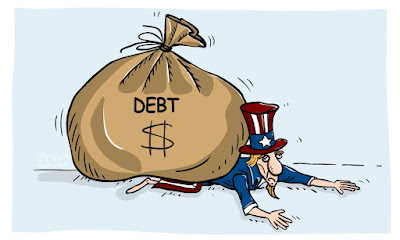Earlier this month,
Zerohedge.com published an essay by an
unnamed JP Morgan economist who predicted that the national economy is headed toward runaway inflation.
According to this anonymous commentator, money in circulation is multiplying through various types of government handouts while "asset prices . . . [are] being propped up by central banks." Thus, he reasons, it is just a matter of time "until inflation goes from 'subdued' to 'out of hand.'" Indeed, the economist predicts, "If central banks have no or a soft-washed inflation mandate we are headed toward a Weimar Republic style inflation setup."
That prediction sounds scary, but what in the hell does it mean?
I had only a hazy notion of the Weimar Republic in the 1920s when inflation in Germany got crazy out of control. I recall seeing photographs of people carrying German currency around in wheelbarrows. But what does the Weimar experience have to do with our national economy? I was clueless.
So I read some books on the German economy in the 1920s. The Weimar Republic, I learned, was created in 1919 after Germany lost the First World War. The German monarchy collapsed in November 1918, Kaiser Wilhelm fled to Holland, and a constitution was drafted in the Germany city of Weimar.
When World War I began, the German mark was valued at around 4.2 marks to the dollar. When the war ended, the allies (France, Great Britain, and the United States) imposed harsh reparations on Germany, and the mark's value dropped to 7.4 to the dollar.
From November 1918 until the mark was finally abandoned in 1923, Germany was caught in a vicious inflationary spiral until the mark ultimately fell to
4.2 trillion marks to the dollar. In other words, it was worthless.
How did that happen? A multitude of factors were at work, but it seems that Germany's inflation during the early 1920s was mostly a result of carelessness, government subsidies to industry and state-owned railroads, and the government's effort to keep German workers employed and support a half-million war widows and 1.5 million disabled former soldiers.
In the end, German printing presses were running around the clock in a vain effort to supply paper currency that was deflating in value almost by the hour. Salaried workers and people living on pensions were driven into poverty, and hunger became widespread.
All this suffering and despair fueled radical political parties--Bolshevik-style communism, right-wing paramilitaries, and ultimately--the Nazis. Hitler himself pointed out that Germans with billions of marks were starving.
Is the United States headed in that direction, as the unnamed JP Morgan economist predicts? Maybe.
Our accumulated national debt is now $25 trillion, and dozens of states and cities are running deficit budgets. A bill is currently working its way through Congress that would spew out $3 trillion, with part of this money going to prop up state and local governments. At the rate we are moving, the U.S. will see its national debt grow to $30 trillion within the next couple of years.
The federal government is also propping up the higher-education industry with student-loan money that has enabled colleges and universities to increase their tuition at twice the annual rate of inflation. More than 45 million Americans are burdened by student loans that total $1.6 trillion.
Our spendthrift economy has enabled the U.S. to drop its unemployment rate to a historic low--last year it was only about 3 percent. If our government restores some fiscal discipline, that rate will inevitably rise. In the summer of 1923, when inflation was utterly out of control, the German unemployment rate was only 3.5 percent. Two months later, after the Reich restored fiscal discipline, unemployment rose to 23.4 percent.
Germany's inflation during the Weimar years destroyed the nation's middle class. The American middle class has been shrinking for the last 20 years, and many middle-income workers are losing ground.
I do not believe the United States can continue propping up more than 4,0000 colleges, universities, and trade schools with federal student-aid money. When all this comes crashing down, thousands of people with good jobs in the groves of academe will be out of work.
Small, liberal arts colleges are already closing at an accelerating rate, and regional public colleges are laying off staff and faculty.
When inflation breaks out in the U.S. economy, the wealthy and the financial speculators will do just fine. It is the middle class that will suffer, including a lot of people working in colleges and universities who now think they have bullet-proof job security.
 |
| The Weimar years: When German money was worthless |
References
Ferguson, Adam. W
hen Money Dies: The Nightmare of Deficit Spending, Devaluation, and Hyperinflation in Weimar Germany. New York: Public Affairs Publishing (2010) (originally published in 1975).
Friedrich, Otto.
Before the Deluge: A Portrait of Berlin in the 1920s. Harper Perennial (1995) (originally published in 1972).
Taylor, Frederick.
The Downfall of Money: Germany's Hyperinflation and the Destruction of the Middle Class. New York: Bloomsbury Press (2013).












